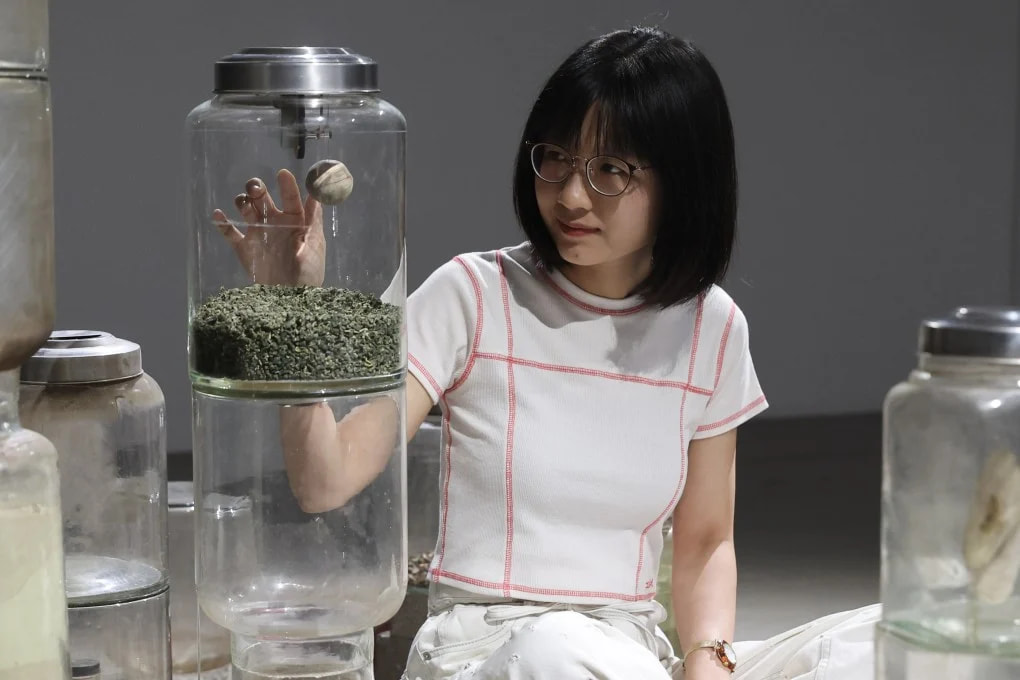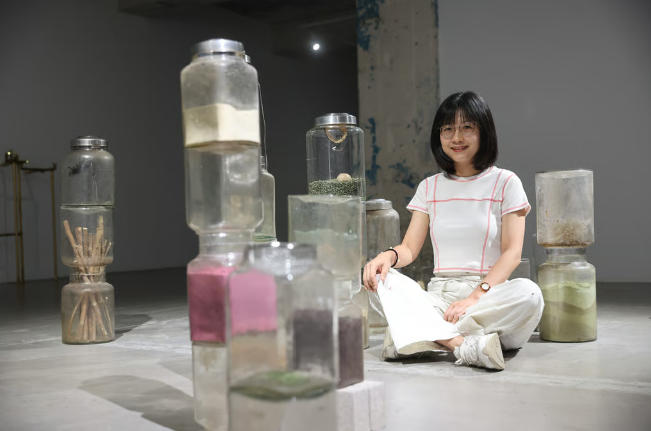
 i_need_contribute
i_need_contribute
Born into a family of traditional Chinese medicine (TCM) practitioners, Hong Kong artist So Wing-po was never tempted to follow in her parents’ footsteps.

Rather, a creative sensibility emerged from her childhood fascination with the family’s TCM pharmacy in Sheung Wan, a space overflowing with herbs, fruit and animal parts. Now, the 40-year-old has gained recognition for transforming those materials and the holistic philosophy embedded in TCM into a distinct visual language.
In her hands, dissected and dried cures seem like living entities, appearing in large-scale installations, sculptures and videos in which they hint at, but are also at a remove from, their traditional uses.
Take her kinetic installation Sea Ear Hi Hat (2020), made up of over a dozen abalone shells – a material used in TCM to cleanse the liver, also known as “sea ears” – that she motorised to open and close like hi-hat cymbals. Their uncanny appearance, steady exhalations, resemblance to human ears and known healing properties imbue Sea Ear Hi Hat with an arresting vitality.
Since her debut solo exhibition at Tai Kwun in 2018, her ability to incorporate the microscopic in installations that speak to universal concerns has been sought after around the world.
In August, she is set to exhibit in the Seoul Mediacity Biennale, having taken part in international exhibitions including the 13th Taipei Biennale and 14th Shanghai Biennale in 2023.
Curator Li Yuanyu, who worked with So on her “Take Turns” exhibition at Para Site in Hong Kong earlier this year, points out that her art is also deeply rooted in the city’s cultural landscape.
Li recalls that working with So “felt like a series of evolving experiments”, through which objects, materials and ideas forged new relationships.
“In the face of Hong Kong’s rapidly shifting cityscape, her work preserves what is disappearing and reimagines it in poetic new forms.”
Artist and educator Kurt Chan, So’s former professor at Chinese University’s Master of Arts in Fine Arts, says that So stands out among Hong Kong’s new media practitioners.
“We often have a gender bias, assuming that female artists are weaker at applying scientific and mechanical elements,” he explains, but So has mastered her research-based approach while making art that is accessible to both local and international audiences.

So Wing-po with her artwork “Polyglot: Mulberry” (2023), a large-scale installation that appears equal parts ecosystem, playground and science experiment. Photo: Edmond So
So uses materials salvaged from defunct Chinese pharmaceutical shops, or from the land and sea. From fruit seeds and dried fauna to insects and shells, these objects find a new home in the artist’s To Kwa Wan studio, where she meticulously categorises and stores them for future projects.
“I was fortunate to have grown up quite freely,” she says. “My parents seldom placed any constraints on what I wanted to do.”
However, she recalls that she rarely ventured beyond the walls of her family’s Sheung Wan pharmacy, let alone Hong Kong’s Central and Western district. And so her early encounters with plants and animals were not in their usual forms but distilled into medicines. That, she says, has led to an artistic impulse to find meaning beyond the surface.
In 2003, instead of joining the family business, she enrolled in Washington University’s Sam Fox School of Design and Visual Arts, in the US state of Missouri. For four years, she lived in the quiet college town of St. Louis, a world away from the bustling neighbourhood and medicine shop that once constituted her universe.
Yet she found herself circling back to familiar shapes and textures, and the desire to make art that was connected to her home, Hong Kong, where she returned after graduating with a bachelor’s degree in fine arts.
Like the modest-looking and often unsightly treasures in the little wooden medicine cabinets in her parents’ shop, meaning and truth can be found or created if you are willing to look beyond the obvious, she says.
“In internal structures and hidden processes, we can see the truth. I feel this way about Hong Kong: there is this veneer of the city which is mainstream, but then there is an invisible side to Hong Kong – such as within the land and the ocean. It is there that I find the truth about this place.”
Her latest solo exhibition at Blindspot Gallery, “Polyglot”, opens with Polyglot: Mulberry (2023), a large-scale installation that appears equal parts ecosystem, playground and science experiment.
Here, medicinal jars display a cornucopia of specimens derived from the self-pollinating mulberry tree: powders in vibrant natural, pink and green pigments, along with bark, leaves, twigs and fungi. As each substance boasts its own TCM quality, their artful conglomeration compels us to reflect on natural regeneration from seed to spore, from life to decay.
Multiple kinetic and auditory elements – most conspicuously, a centrally placed, motorised wooden ball that audibly thuds against the side of its glass container – enliven Polyglot: Mulberry.
So carries these sensuous elements throughout the exhibition. Sea Ear Hi-Hat (Take Turns) (2025) repurposes the kinetic abalone shells from her earlier work. In a separate, dimly lit room, a small creature-like sculpture, Magnolia Bud (2025), softly oscillates from the vibration of its internal motor. It is made from a 3D-printed shell that is engulfed in fine hairs collected from magnolia buds – which grow to protect the plant in cold environments. Spot-lit on its pedestal, the work appears to squirm of its own volition, as if ready to hatch.
So used salvaged herbal medicine drawers for The Bookmaking Habits of Select Species (in the Drawers) (2025). The work is named after Ken Liu’s 2012 science fiction story of the same name about how different species record knowledge.
The dark cabinets are illuminated from within by LED panels, drawing attention to the minuscule apertures blemishing the wood. These constellations of holes are made by small bugs attracted to the drawers and whatever material once lay within – a common nuisance for herbalists. So, however, finds beauty in the hidden inscriptions, positioning the bugs’ etchings as a code for viewers to decipher.
What exactly these markings signify, she leaves open to interpretation. But through the work’s dialogue with the others displayed in “Polyglot” – and indeed, through her practice as a whole – viewers may find a suggestion of how unseen processes and indelible traces are as vital and meaningful as objects and images that we so readily consume.
In a city like Hong Kong, where the old and new collide strenuously, where change is an ever-present state to be accepted, So’s art invites us to look closer, to listen harder, to find wonder in those fleeting moments of transformation.